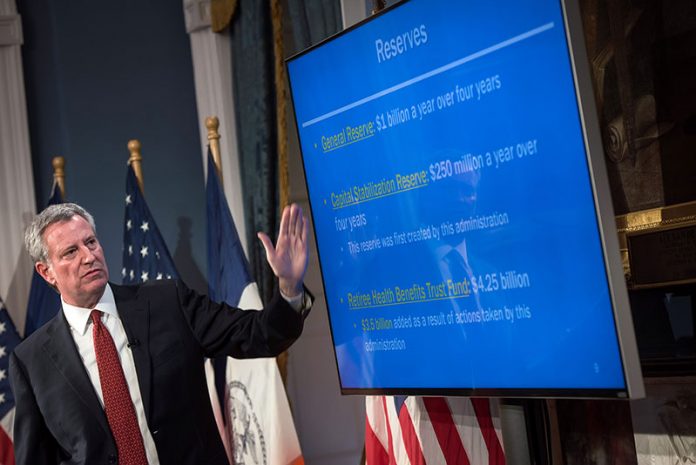NYC mayor Bill de Blasio’s fiscal year 2019 budget represents a substantial increase in investment to maintain and expand the city’s core infrastructure over previous years, according to a recently-released New York Building Congress (NYBC) analysis.
The city is proposing to increase capital spending by $2.8 billion – from $9 billion in 2018 to $11.8 billion in 2019 – and then an additional $1.7 billion in 2020 (to $13.5 billion total).
With the proposed capital spending plan, there’s greater potential to build the necessary infrastructure essential to the city’s continued growth. New York faces a number of infrastructure vulnerabilities that, if left unchecked, could wreak havoc on the NYC’s economy, competitiveness and quality of life, NYBC says in a news release.
At the same time, these ambitious goals will test the city’s capacity to execute a vastly increased workload. Sustaining such large increases will require aggressive implementation and skillful management from the city’s capital agencies, the Office of Management and Budget, and the Comptroller’s Office, which collectively oversee capital projects and process payments for work.
“We are thrilled at the level of investment in core infrastructure being proposed by Mayor de Blasio,” NYBC president and CEO Carlo A. Scissura said in a statement.
“The prolonged stability and growth of the city is contingent on the fundamentals of good schools, safe and reliable transportation, and a basic state of good repair of the city’s infrastructure. We look forward to working with the mayor and his administration to implement their ambitious goals in the months and years to come.”
The analysis finds that NYC remains the single largest investor in its public schools, roads, libraries, sewers and other critical facilities across the five boroughs.
NYBC says several measures of the budget increase are notable including:
- The city plans to spend almost $9 billion on capital projects in the current 2018 fiscal year, which ends this June, higher than all but two peak years of the previous administration;
- The city is proposing to spend almost $52 billion during fiscal years 2019 through 2022, significantly more than any similar period on record; and
- Capital commitments, which indicate the value of new contracts registered with the city comptroller and are a key marker of longer-term capital investment, are projected by the city to be $79.6 billion over fiscal years 2018-2022. This figure is unprecedented.
NYBC says it will monitor these commitment levels over time to see if they are attained.
The NYBC analysis also finds that these planned increases are affordable, based on the city’s current financial outlook. The city projects its debt service costs will remain well below 15 percent of total tax revenues, which is considered the threshold for responsible debt financing.
NYBC says notable elements in the commitment plan include:
- The Department of Environmental Protection projects $13.7 billion in new commitments over five years for the city’s water and sewer system. Over $70 million includes completion of stage two of the City Water Tunnel #3.
- The School Construction Authority proposes to commit $13.9 billion to capital projects for public schools over the same five years.
- The Department of Transportation’s $12.3 billion commitment plan over five years is by far the agency’s largest on record, and 80 percent percent greater than the de Blasio administration’s first budget in 2014. Work includes the $294 million for reconstruction of the Manhattan Bridge.
- NYC Health and Hospitals Corporation proposes to commit $3.6 billion over five years, a 92 percent increase over the mayor’s first capital proposal, in fiscal year 2014.
- The Parks Department will commit $4 billion over five years, remaining constant with last year’s Preliminary Budget, which represented a record level of commitments for the agency.
NYBC says in its statement that it assesses that one reason for the growth in the mayor’s preliminary budget is that the administration required city agencies to provide more accurate forecasts for the later years of their proposed budget starting last year. These exercises have reduced front-loaded agency budgets, typical of past budgets, and have forced agencies to identify projects that will happen in the third and fourth years of the plan.










